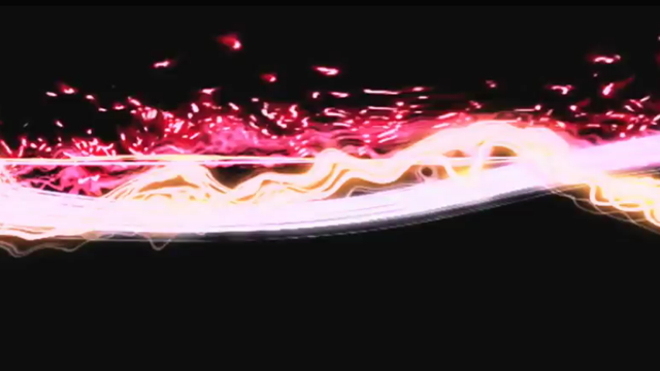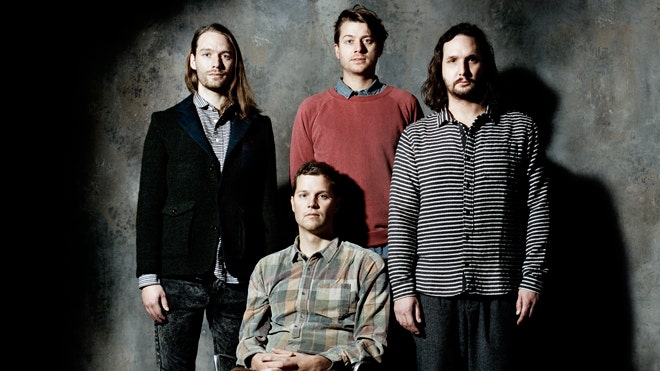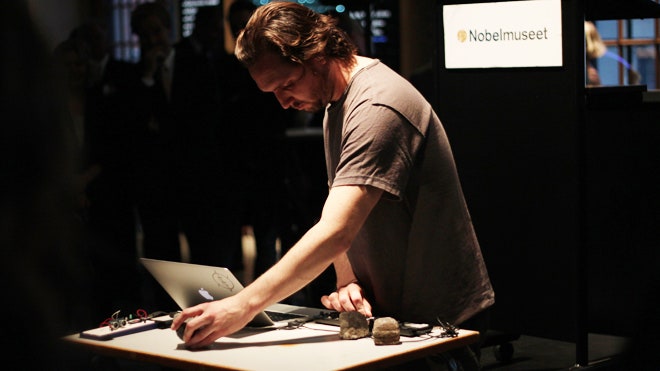The Radioactive Orchestra: Band uses nuclear isotopes to make music
Every second in your body, thousands of tiny isotopes are bursting with radioactive decay. And, all around you, imperceptible gamma rays explode in a brilliant but invisible lightshow. And they've just formed a live band.
Yes, you read that correctly. But it's all for science: The Radioactive Orchestra 2.0 is part of a Swedish project to help us understand how low-energy radiation works, by showing the energy patterns of nuclear isotopes.
is part of a Swedish project to help us understand how low-energy radiation works, by showing the energy patterns of nuclear isotopes.
The music sounds like a techno-version of your science curriculum … if Moby were involved.
Swedish musician Kristofer Hagbard conceived of the orchestra about a year ago and released an album last spring, but the new 2.0 version of "the band" allows him to perform live in front of an audience.
The artist and composer uses a small, low-activity sample of radioactive material such as uranium on stage. He moves the sample close to a gamma spectrometer and then farther away, creating a pulsating rhythm. He can quickly create repeating loops from the live isotope signatures and form a complete song that wouldn't be out of place on a modern alternative radio station.
The project provides a musical representation of something we can’t see in the universe, Hagbard told FoxNews.com.
“This can be looked at as a piano for high energy photons, so every detection gives us a note,” Hagbard said. “The musical instrument is as good as the gamma spectrometer we are using.”
The live performance is not just for show, however. Inside the detector, there is a large crystal of sodium iodide. When the radioactive energy strikes the detector, the crystal produces a colored beam of perceptible light, which is then mapped to a musical note by a computer program.
Tim Lundström, a physicist at a Swedish nuclear safety and training organization called KSU, told FoxNews.com that the radioactive orchestra is a good way to represent nuclear energy because it correlates so accurately to what we know about radioactive material. Lower energy beams produce colors like blue or green whereas higher level radioactive materials produce red tones.
“The decay of Cobalt-60 gives gamma-radiation of two very distinct energy levels, 1.17 MeV and 1.33 MeV. These numbers can be translated to two different tones,” Lundström said. The project is designed to help people understand how radiation is so prevalent in the universe and in our own bodies, he explained: We can better understand radioactive energy through the music metaphor, which also serves to lessen some of the fear surrounding nuclear power.
“Every second, 4,000 to 5,000 nuclei decay in your own body, caused by natural radioactive isotopes like potassium 40 and carbon 14. We also have radiation from the universe and from the ground.”
The ground-breaking project is an attempt to explain a complex mystery: We still don’t know exactly how the mechanism of nuclear decay works, Lundström said. “We know that nuclei with high energy wants to get rid of the energy and decays to accomplish that. High energy nuclei is caused by an imbalance between the number of protons and neutrons in the nuclei,” he said.
For Hagbard, the goal is not just to create a science project. Instead, he hopes to capture the imagination and help us to think outside of the box. “The goal is not to create the ultimate sonification of radiation, but to experiment with science as a starting point for making art,” he said.
Yes, you read that correctly. But it's all for science: The Radioactive Orchestra 2.0
 is part of a Swedish project to help us understand how low-energy radiation works, by showing the energy patterns of nuclear isotopes.
is part of a Swedish project to help us understand how low-energy radiation works, by showing the energy patterns of nuclear isotopes.'The goal is not to create the ultimate sonification of radiation, but to experiment with science as a starting point for making art.'- Kristofer Hagbard, Swedish musician
The music sounds like a techno-version of your science curriculum … if Moby were involved.
Swedish musician Kristofer Hagbard conceived of the orchestra about a year ago and released an album last spring, but the new 2.0 version of "the band" allows him to perform live in front of an audience.
The artist and composer uses a small, low-activity sample of radioactive material such as uranium on stage. He moves the sample close to a gamma spectrometer and then farther away, creating a pulsating rhythm. He can quickly create repeating loops from the live isotope signatures and form a complete song that wouldn't be out of place on a modern alternative radio station.
The project provides a musical representation of something we can’t see in the universe, Hagbard told FoxNews.com.
“This can be looked at as a piano for high energy photons, so every detection gives us a note,” Hagbard said. “The musical instrument is as good as the gamma spectrometer we are using.”
The live performance is not just for show, however. Inside the detector, there is a large crystal of sodium iodide. When the radioactive energy strikes the detector, the crystal produces a colored beam of perceptible light, which is then mapped to a musical note by a computer program.
Tim Lundström, a physicist at a Swedish nuclear safety and training organization called KSU, told FoxNews.com that the radioactive orchestra is a good way to represent nuclear energy because it correlates so accurately to what we know about radioactive material. Lower energy beams produce colors like blue or green whereas higher level radioactive materials produce red tones.
“The decay of Cobalt-60 gives gamma-radiation of two very distinct energy levels, 1.17 MeV and 1.33 MeV. These numbers can be translated to two different tones,” Lundström said. The project is designed to help people understand how radiation is so prevalent in the universe and in our own bodies, he explained: We can better understand radioactive energy through the music metaphor, which also serves to lessen some of the fear surrounding nuclear power.
“Every second, 4,000 to 5,000 nuclei decay in your own body, caused by natural radioactive isotopes like potassium 40 and carbon 14. We also have radiation from the universe and from the ground.”
The ground-breaking project is an attempt to explain a complex mystery: We still don’t know exactly how the mechanism of nuclear decay works, Lundström said. “We know that nuclei with high energy wants to get rid of the energy and decays to accomplish that. High energy nuclei is caused by an imbalance between the number of protons and neutrons in the nuclei,” he said.
For Hagbard, the goal is not just to create a science project. Instead, he hopes to capture the imagination and help us to think outside of the box. “The goal is not to create the ultimate sonification of radiation, but to experiment with science as a starting point for making art,” he said.
Read more: http://www.foxnews.com/science/2012/11/14/radioactive-isotopes-used-to-create-live-music/?intcmp=features#ixzz2CTWdestL



No comments:
Post a Comment